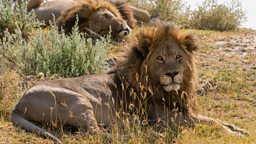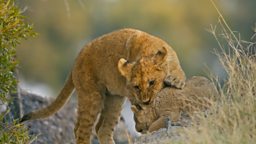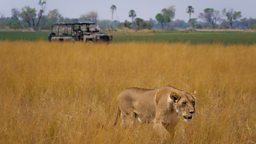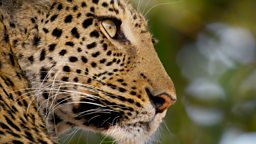Cat spotlight: Pobe the cheetah
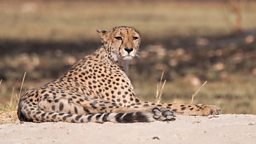
I think people naturally root for the underdog, so perhaps that’s why Pobe, a 7-year-old female cheetah quickly became my favourite big cat on Xudum island.
Cheetahs are quite literally ‘scaredy-cats’
The numerous challenges that Pobe faces every day as a solitary cheetah are palpable. You can see it in her body language; slinking through the shadows and glancing over her shoulder in the pockets of safety between lions and leopards.
Cheetahs are quite literally ‘scaredy-cats’, lone agents without the back-up of a pride, they can be chased off their kills by a single barking baboon. These characteristics and Pobe’s understandable desire to stay under the radar made her very hard to track, but I secretly loved her for it. It made those moments with her even more special.

On one occasion we’d managed to keep up with Pobe through to sunset. Equipped with the thermal camera, we were set on not losing her, because after a failed hunt attempt earlier that day we knew she’d be hungry and undoubtedly on the prowl again at first light.
She was curled up in a tiny ball of spotty fur
We were also intrigued as to what a traditionally diurnal species might get up to in the dark. What we found out was, when undisturbed, they really don’t get up to a huge amount!
We worked in 2-hour shifts, taking turns to watch her sleep. She was curled up in a tiny ball of spotty fur (her spots, even visible on the thermal camera!). Occasionally she’d stand up, stretch and reposition to get the ‘cool side of the pillow’.
We’re often encouraged not to anthropomorphise animals, but I really couldn’t help but notice our shared sleeping style, because I also favour the cosy foetal position. Spending the night so close to a sleeping cheetah under the Delta’s dazzling Milky Way felt like a dream, apart from the lack of sleep I had, of course.
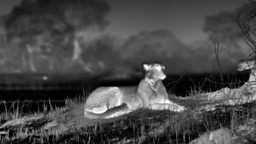
Predictably, at the first glimmer of morning light on the horizon, Pobe was up and keeping us on our toes once again. It was important to stay close to her at all costs.
Filming them is akin to a cardio sport
Xudum island is an extraordinary environment where you can drive out of the Big Cats 24/7 film camp and find a lion sometimes within just 10 minutes of searching. But cheetahs are an entirely different beast. We spent hours, days, sometimes even weeks looking for cheetahs, travelling hundreds of kilometres to catch a glimpse of those elusive banded tails.
They are essentially straw-coloured needles in the giant haystack that is the Delta – and it’s not helped by the fact that they are a vulnerable species (according to the IUCN Red List), with fewer than 7,000 cheetahs left in the wild today.
But the best thing about cheetahs is that putting the effort in to find them is infinitely worth the payoff because you are guaranteed an epic rollercoaster of a time. They can accelerate from 0-60mph in 3 seconds. They go from chilling on a termite mound to executing a full-speed kudu calf take-down with only a moment’s notice. Filming them is akin to a cardio sport. So much so, that my smart watch kept alerting me to high stress levels and to ‘take a breath’.
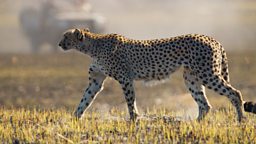
Despite the constant pressure, I’d argue that there is nothing more beautiful than witnessing a cheetah mid chase. When slowed down four times by the camera, you can really appreciate their 7-meter-long strides, their rudder-like tails, twisting and whirling like a ballet dancer-turned Olympic sprinter. I strongly feel that mother nature exemplified herself when it came to cheetahs, because they are perfectly created for their job.
arguably the most swagger and pizzazz of all of the big cats
Through wildfires, floods and all the while surrounded by one of the world’s biggest lion prides and a handful of leopards, the odds seem to be cruelly stacked against Pobe and her kind. Pobe’s life showed itself to be as fragile as the everchanging landscape around her, one that she must constantly morph with in order to survive.
But what she proved to me is that, although at the bottom of the big cat pecking order, cheetahs can adapt and eek out lives, even in the toughest of conditions, with arguably the most swagger and pizzazz of all of the big cats. So, if you’re looking for a lesson in adversity, follow a cheetah - or better, a cheetah named Pobe.
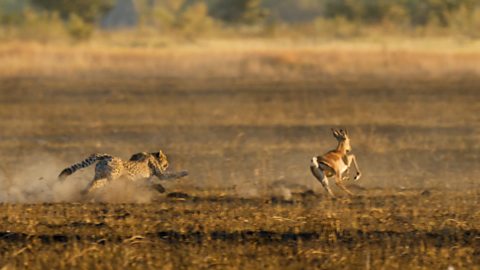
A cheetah goes full tilt to hunt an impala
Pobe the female cheetah engages in a high speed chase of an impala in an open floodplain.
